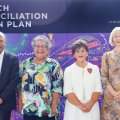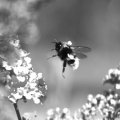The University of Queensland is constructing a second high-tech testing facility for wireless communications as part of expansion of activities of its Wireless Communications Group.
The new planar near-field antenna measurement system is one of only a few in the southern hemisphere, and is believed to be the first at an Australian university. CSIRO's Division of Radio Physics in Sydney maintains the only other such facility in the country.
Head of the Electrical and Computer Engineering Department's Wireless Communications Group Associate Professor Marek Bialkowski said the new facility would enhance the group's ability to provide professional, world-standard testing for the rapid growth market in wireless communications systems.
This market includes cellular telephones, military mobile communications, radio and television transmission networks, personal communications, wireless emergency services, mobile, fixed and direct broadcast satellites and microwave relay and distribution systems.
'The new system will provide similar capabilities to advanced technical facilities for high performance testing in the U.S., Europe and Japan,' he said.
The Wireless Communications Group includes four senior academics, 13 PhD and seven masters candidates, 20 undergraduates and a laboratory manager.
Its special area of expertise is mobile satellite antennas. However, researchers are shifting this substantial knowledge base into the current growth area of personal wireless communications.
'Over the past five years the research group has produced many breakthroughs in wireless and satellite communications. They include an innovative briefcase satellite phone, an omni-directional mobile electronic tracking satellite antenna, and high efficiency array antenna systems,' Dr Bialkowski said.
'We have some of the best research and development facilities of any university in Australia for microwave and high frequency projects.
'The new testing range is part of an upgrading of our facilities to take on substantial new research in areas as diverse as digital mobile phones, global low earth orbital satellites for receiving mobile phone communications, and passive microwave security cards.'
The group this year signed a Memorandum of Understanding with the Russian Space Agency, allowing the University of Queensland to become the first organisation in the southern hemisphere and one of the first internationally to gain access to the world's only Low Earth Orbit Satellite system, launched in northern Russia on February 15.
Dr Bialkowski said in wireless communications systems, antennas played a paramount role in establishing a communication link between different destination points. Diversified applications of wireless communications meant increasing demand for more sophisticated antennas but their design was becoming less predictive.
'Consequently, before final manufacture these antennas require extensive testing, particularly on such parameters as radiation patterns,' he said.
'In the past, obtaining an antenna's radiation patterns involved measurements in open space, across the region satisfying the so called far-field condition.
'This approach led to a variety of problems including weather effects, multi-path, antenna distortions and even security. Because of this situation, there has been a lot of demand for indoor antenna testing systems. These are of far-field and near-field type.
'The idea of developing indoor antenna testing ranges has been pursued for some time at the University of Queensland, with two products: a far-field range developed in the Department a few years ago and the near-field range currently being constructed.'
The University of Queensland's existing far-field anechoic chamber has the ability to acquire far-field radiation patterns for antennas operating in the frequency range of 500MHz to 18GHz.
The facility is less useful for an antenna with high gain, for example antennas required for reception of direct broadcast satellite TV programs. The restriction is overcome with near-field range testing, which can measure radiation characteristics of an antenna in the near-field zone, and by using the near-field to far-field transform applied to the measured data.
Dr Bialkowski said he expected the new facility to be used by research groups at the University of Queensland, Griffith University and Queensland University of Technology, and government and industry partners.
Among the first high performance tests will be those conducted on a flat-profile antenna invented within the research group. The antenna is cheap, robust, easy to mass manufacture, and matches the performance of large dish antennas.
The Flat Direct Broadcast Satellite (DBS) antenna was co-invented by Dr Bialkowski and PhD student Paul Davis who believe that it is capable of replacing larger dish antennas like those currently in use for Galaxy TV, US, and European Pay TV.
The Flat DBS Antenna is also multipurpose. Recently the research group has been investigating many other potential commercial mobile satellite applications such as fitting systems to commercial aircraft for live, inflight pay TV systems, as well as investigating its usefulness in military applications.
The new testing facility will also be used to examine the effects of the human body on performance of hand-held mobile phones. The work by PhD student Mark Rydstrom looks at radiation absorbed by the body. It targets the development of new, multiple antenna systems to overcome fading effects due to the physical human presence.
Dr Bialkowski said the new facility, which was valued at approximately $100,000 plus software if constructed commercially, was completed on a shoestring budget using an Australian Research Council small grant which he held with another member of the Wireless Communications Group, Dr Nick Shuley, and with Departmental funding.
It was co-designed by Dr Bialkowski and Mr Davis, and built using the expertise of Departmental Mechanical Workshop technicians Keith Lane, Bob Slack and Wayne Jenkins, who overcame technical problems to improve its capabilities. The software to automate the near-field scanning process was all produced in-house by Mr Davis, and it will form part of his PhD thesis.
For further information, contact Dr Bialkowski, (telephone 3365 3563, email meb@elec.uq.edu.au).



